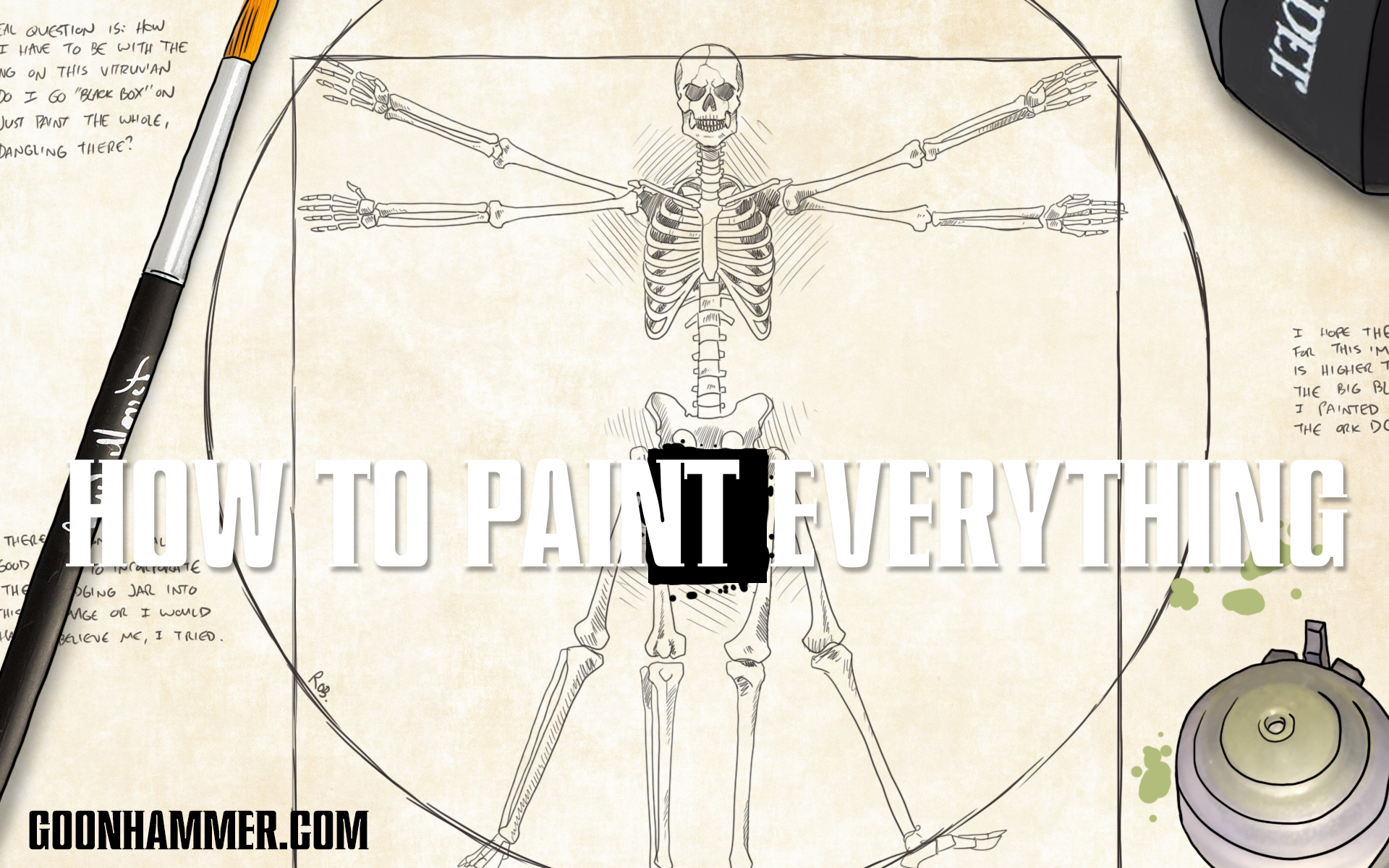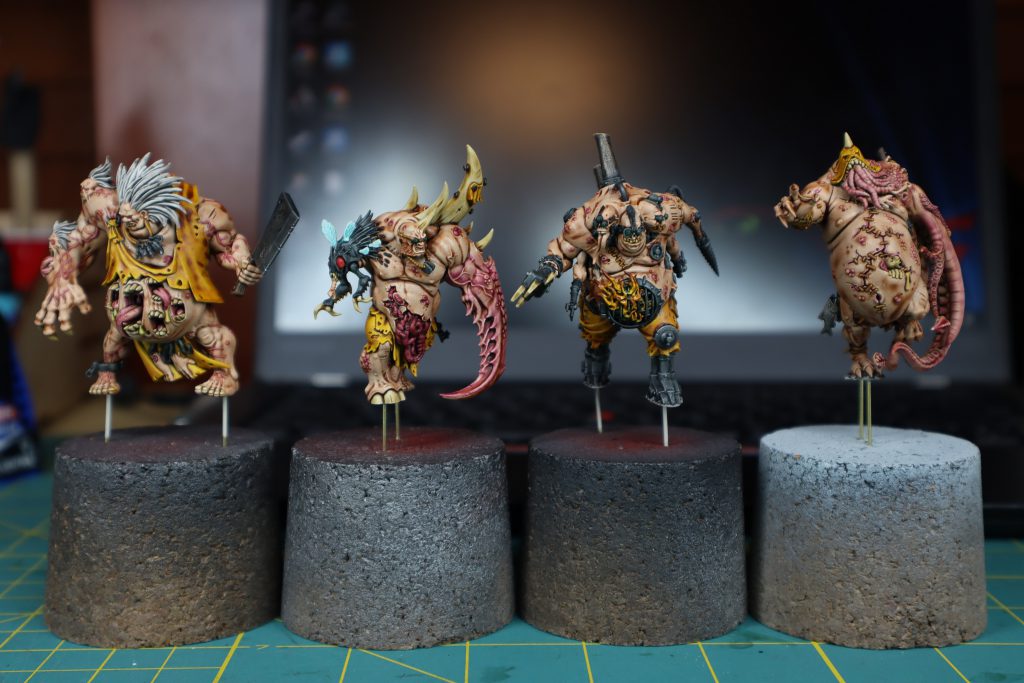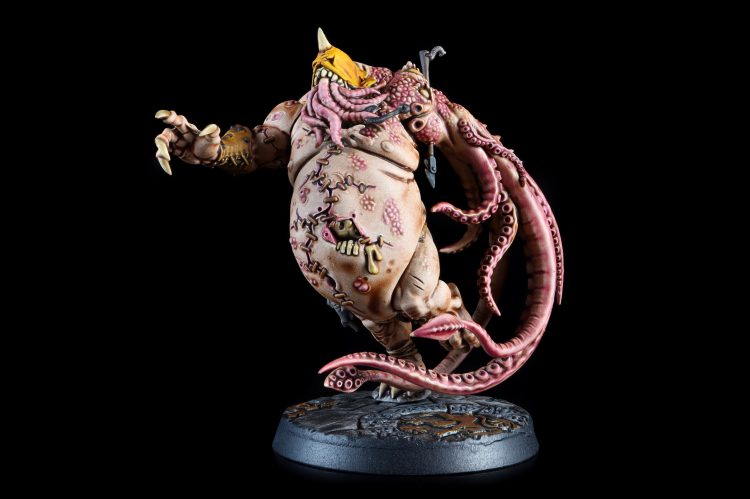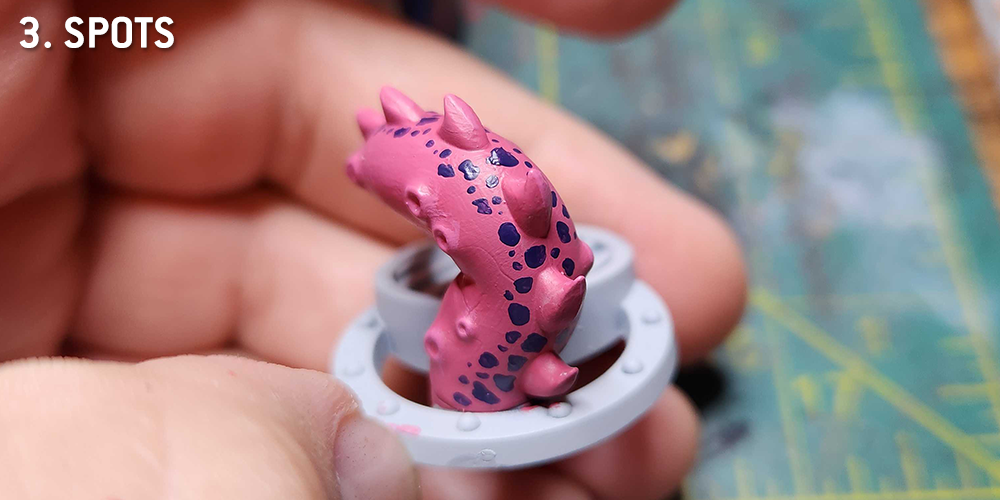In our How to Paint Everything series we look at how to paint well, everything, with different techniques, approaches, and color schemes to give you multiple ways to tackle your hobby challenges. In this article we’re looking at how to paint the twisting, writhing tentacles that often protrude from the gaping maws and distended bellies of fantasy and sci-fi creatures.
Few things make for scarier monsters than writhing masses of tentacles. Whether featured in gaping maws or hanging off the face of an eldritch horrorterror beyond all rational comprehension, tentacles are a great way to make a model look immediately gross and scary. They’re also great for adding a splash of color to models that might otherwise be dark and relatively monochrome.
When it comes to Warhammer, you’ll most often find tentacles on models related to Nurgle, whether in Age of Sigmar or Warhammer 40,000, though Tyranids frequently sport them as well.
There isn’t a ton to painting tentacles – we’re going to cover a few different shades of pink and purple in the tutorials below – but there are some interesting techniques to consider when it comes to shading and finishing them.
Covered in this Article
- Techniques for painting tentacles of various colors, but mostly pink and purple.
- Techniques for adding texture to your tentacles to make them appear slimy and wet.
- A surprisingly (and disturbingly) large amount of teeth, if we’re being honest.

Andrew Haywood - Click to Expand COVID-19 hit, and the world shut down. Forced to subsist on nothing but instant ramen, canned goods, and frozen meals, not much in my life changed. That is, until I started burning through my backlog and running out of models to paint. Digging through my bookshelf of boxes, I found the Kill Team Rogue Trader box and decided it was an apt time to paint models afflicted by a reality-altering infection. These were a bit of a challenge for me, as I didn’t have much experience building or painting organic models. Not much call for organs within the Adeptus Mechanicus. Fortunately, I had just finished painting 50 Skaven in a month, so I had some skin-painting momentum carrying me forward. The recipe for tentacles here is largely the same as how I painted those Skaven tails. Start by priming the models with Games Workshop’s Wraithbone primer, then paint them with Guilliman Flesh Contrast Paint. Next load a brush with Contrast Medium and then basically tap it to Volupus Pink and brush that on. Thin it with even more Contrast Medium while wet, if necessary. Note: I mean tap it to Volupus Pink – you want almost none of it on the brush. And that’s it! Strikingly effective, for very little work.

MildNorman's Method - Click to Expand Hello there guys, ghouls, and, thampires. Today I’m gonna walk through my method for speed painting tentacles. Its relatively simple and nothing crazy but the results will make any cultist of Nurgle green with envy (or gangrene, not really sure). So lets go ahead and get started! Say hello to our subject today, Jeffery. We start off with getting a zenithal prime on the model. For those who don’t know, this is a technique where you start the model as primed black, then prime with white from above. I do this with just Chaos Black spray and then spray from above with White Scar spray, but you can do this with any brand or even by priming black and dry brushing white. Doing this will push our translucent paints highlighting abilities even further and give the initial coat even more punch. You’ll notice I went and painted all the skin before touching the tentacles. This wasn’t by accident. Tentacles are often an accent that you want to pop and stand out drastically from the rest of your scheme, as such getting an idea of what the other colors that will be present on the model gives you an idea of what will pop next to it. In this situation, since I’m painting with yellowish bone armor and reddish hues in the skin, I wanted something closer to purple and blue. Green would probably have worked here too, but I wanted to accent the skin with that color later. First I applied a blue and purple mix of deep toned translucent paints to the tentacle. Specifically I used Army Painter’s Beowulf Blue and Swarm Purple Speedpaints mixed at about 50:50. This was a bit brighter than I would like so I continued glazing, that said that could be a perfectly acceptable tentacle in the right context so feel free to stop there. Next step is glaze on some Burgundy too push the color closer to purple. Now you may be asking “Why didn’t you just pick a purple you liked and use that?” and my answer is layering in different colored contrasts and glazes makes your tentacle look all the weirder. Tentacles are an organic thing, and most organic things aren’t just one color! so this provides some depth. Anyway, for this step I glazed in some thinned down Murder Scene from Army Painter’s Speedpaint range in a 50:50 mix of that and Speedpaint Medium, but this works just as well with something like Volupus Pink from Citadel. I also use this color on the skin tone I have to make the area the tentacle is emerging from look more like muscle. The last step is to hit the tentacle with a highlight. This can be a bit tricky for a few reasons. First is tentacles are often cylindrical and twist around so it can be hard to decide where to highlight. Second is if you’re keeping your tentacle multi colored for the reasons stated above, then deciding on a highlight color might be hard. For the first problem, think about the angles the tentacle will be viewed from and work to highlight the raised parts of those angles. For the second, just go back to your initial thought of what color you wanted the tentacle to be, I wanted a purple tentacle so I highlighted purple. Specifically I used some of Citadel’s Genestealer Purple. And that’s it! To recap:
Step 1: Undercoat Zenithal White
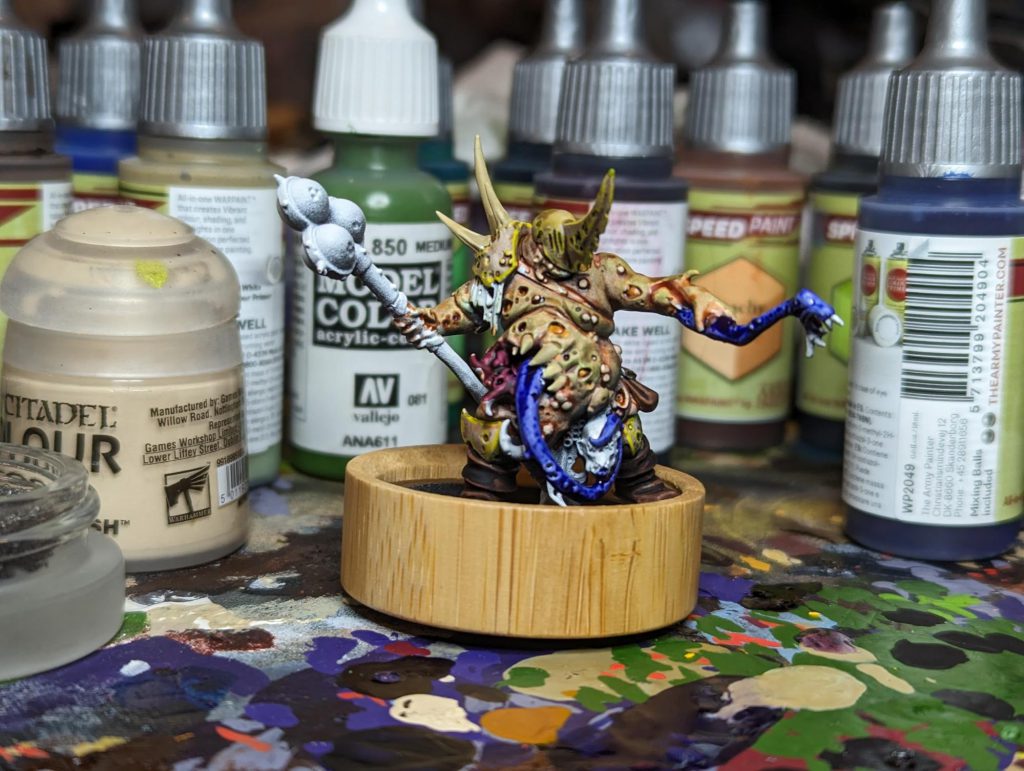
Step 2: Base Coat of Blue/Purple
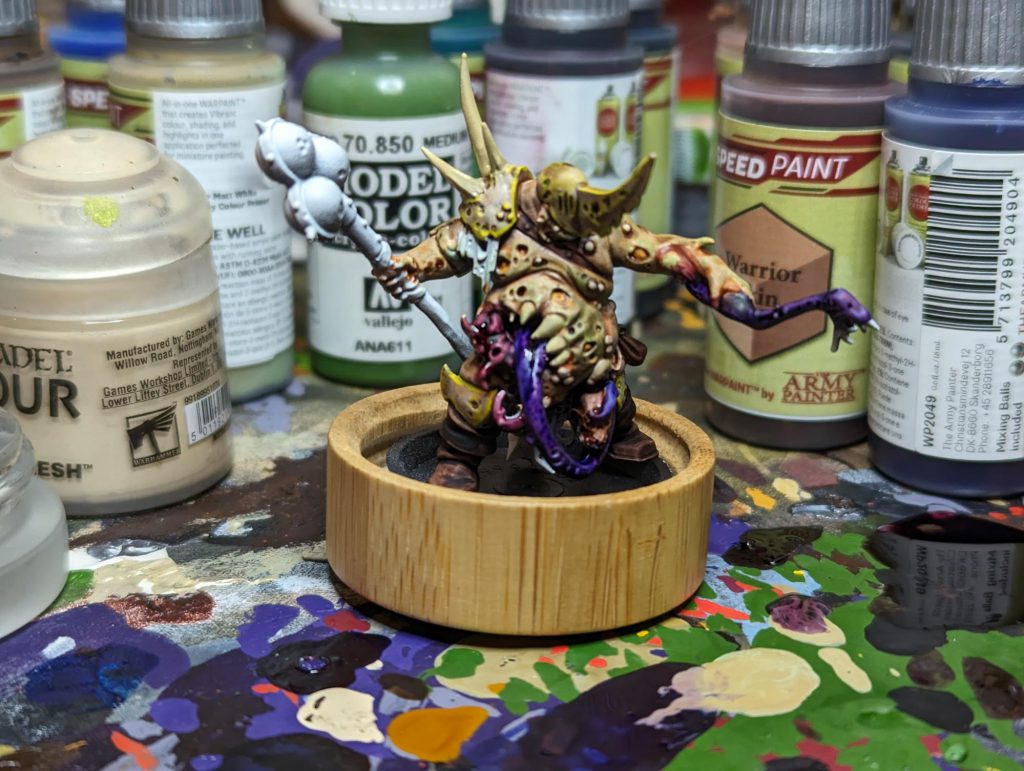
Step 3: Glaze of Burgundy
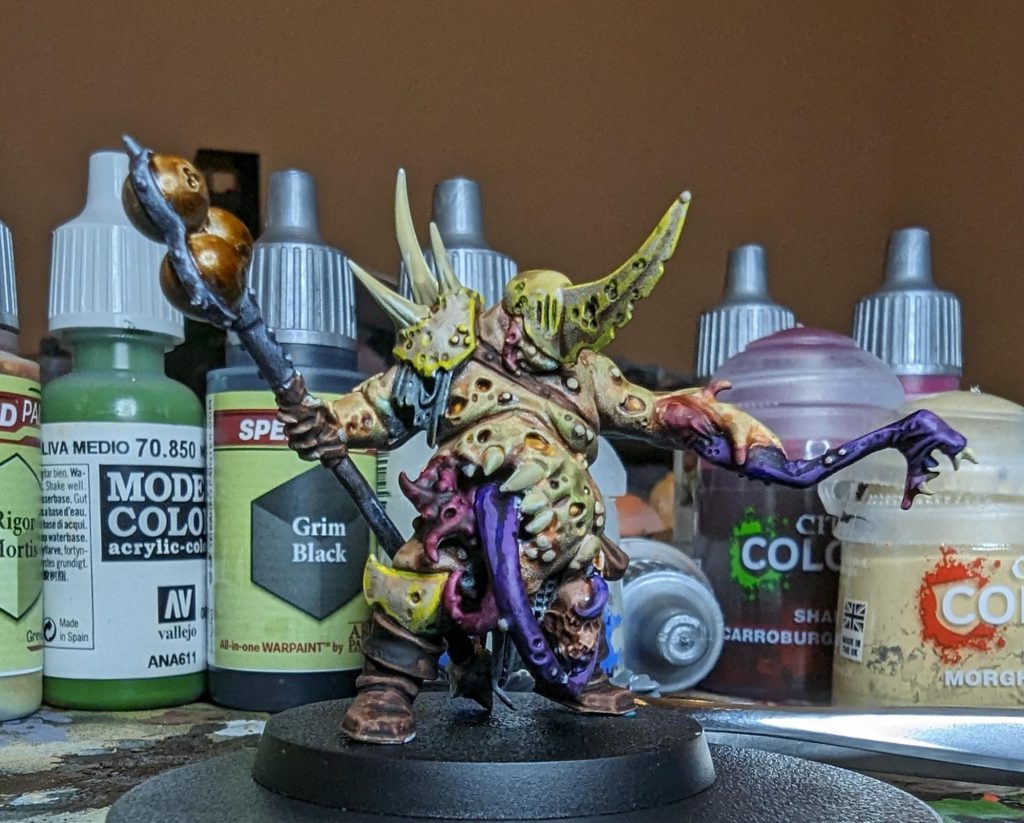
Step 3: Highlight

Robert 'TheChirurgeon' Jones' Method - Click to Expand I like my tentacles like I like my horror movie puppets: wet. When properly painted, a tentacle model should look like it’d slide out of your hand if you tried to pick it up. So I like to accomplish this using a series of gloss coats and technical paints. The actual painting of the thing is otherwise pretty straightforward. Let’s dive in. I started by priming this Necromunda tentacle with Grey Seer primer. Next comes the basecoat. I started here by laying down a coat of Pink Horror, then wet-blending that up to Emperor’s Children. I added a bunch of purple spots to my tentacle using Naggaroth Night. I did some small highlights on these with Xereus Purple. I highlighted the tip of the tentacle, the barbs, and the suckers with thin lines of Fulgrim Pink. This is also the stage where I painted the sewer grate. It’s painted Leadbelcher and washed with Nuln Oil and Agrax Earthshade. Final steps. I painted the manhole and grate with Typhus Corrosion, then drybrushed it with Ryza Rust to give it an old rusted metal look and a gritty texture. Next comes the technical paints. I painted a few globs of Nurgle’s Rot on the cover, and a generous dollop under the tip of the tentacle and in the crook where it’s bending over itself. This gives it a wet, green texture but I want to get the rest of the model. I don’t want to wash out the green completely so the rest of the model gets covered in ‘Ardcoat. Step 1: Priming
Step 2: Pink Basecoat
Step 3: Purple Spots
Step 4: Highlights and Washes
 Step 5: The WETTENING (and other finishing touches)
Step 5: The WETTENING (and other finishing touches)

PierreTheMime's Cthonian - Click to Expand When one thinks upon Lovecraftian horrors, one inevitably thinks of tentacled otherworldly creatures. While Lovecraft did not himself create the Cthonian–Brian Lumley created them some 30+ years after his death–these rather loathsome things have been a staple of eldritch horror stories and games for a long time. They’re giant, horribly dangerous, and make for a perfect nameless enemy. Fantasy Flight Games’ Mountains of Madness game features a number of these tentacled beasts. You can see how I painted them in our article on painting horrors and eldritch beasts.

TheChirurgeon's Mutalith Vortex Beast - Click to Expand You can also find a gaping maw full of tentacles on the Mutalith. I painted one for my Thousand Sons and you can find the full tutorial – including an entire section on the betentacled maw – in its own article, here. The process is largely the same as what I did for the tentacle above, with a little extra highlighting and no spots.
Have any questions or feedback? Drop us a note in the comments below or email us at contact@goonhammer.com.
